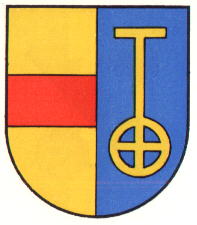Hügelsheim: Difference between revisions
Knorrepoes (talk | contribs) No edit summary |
Knorrepoes (talk | contribs) m (Text replace - "[[Literature" to "{{media}} [[Literature") |
||
| Line 21: | Line 21: | ||
In 1900 the State Archives proposed new arms, combining the symbol with the arms of the Lords of Geroldseck, Lords of Hügelsheim in the 13<sup>th</sup> century. The council approved the arms in January 1901. | In 1900 the State Archives proposed new arms, combining the symbol with the arms of the Lords of Geroldseck, Lords of Hügelsheim in the 13<sup>th</sup> century. The council approved the arms in January 1901. | ||
{{media}} | |||
[[Literature]] : Zier and Fütterer 1966. | [[Literature]] : Zier and Fütterer 1966. | ||
Revision as of 23:14, 8 July 2014
| Heraldry of the World Civic heraldry of Germany - Deutsche Wappen (Gemeindewappen/Kreiswappen) |
HÜGELSHEIM
State : Baden-Württemberg
District (Kreis) : 1972 Rastatt
Official blazon
Schild gespalten, rechts auf goldenem Grund ein roter Querbalken, links auf blauem Grund ein goldener Rost
Origin/meaning
The arms show in the left part the old village symbol of Hügelsheim. Its meaning or origin is not clear, although it has been proposed that it is derived from the symbol of St. Lawrence, the grill, patron saint of a chapel in the village. The symbol appears in a shield in the oldest known seal, dating from the late 18th century. In the 19th century the symbol is transformed into an Orb.
In 1900 the State Archives proposed new arms, combining the symbol with the arms of the Lords of Geroldseck, Lords of Hügelsheim in the 13th century. The council approved the arms in January 1901.
Contact and Support
Partners:
Your logo here ?
Contact us
© since 1995, Heraldry of the World, Ralf Hartemink 
Index of the site
Literature : Zier and Fütterer 1966.











